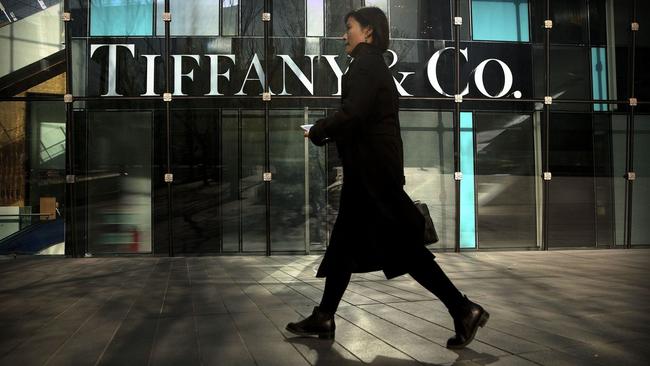LVMH bets it can restore Tiffany’s shine with $23.5bn deal
LVMH Moet Hennessy has plans of taking over Tiffany & Co in a deal worth more than $US16bn ($23.5bn).

The European luxury conglomerate behind Louis Vuitton and Bulgari is taking over Tiffany & Co. in a more than $US16bn ($23.5bn) gamble that it can restore shine to the famed jeweller.
LVMH Moet Hennessy Louis Vuitton and Tiffany have reached a preliminary agreement on a deal that values the company at $US135 a share, according to people familiar with the matter. The boards of the two companies were working on Sunday to complete a deal.
A deal would give LVMH a classic American brand that has struggled with weak demand at home and abroad. It is also a bet on China’s economy and its consumers, whose fast-rising incomes have made them the luxury industry’s most important customers. In search of growth, Tiffany is building flagship stores in several Chinese cities.
The acquisition would be the biggest yet by LVMH under Bernard Arnault, the French billionaire who has been the luxury group’s chief executive and controlling shareholder for three decades. It tops the $US13bn Mr Arnault paid in 2017 to bring all of the French fashion house Dior under the ownership of LVMH.
LVMH, which owns 75 brands, is one of Europe’s most valuable companies worth $US220bn by creating a mass market for luxury goods. Louis Vuitton, which by some estimates accounts for one-quarter of the Paris-based company’s revenue, sells leather goods starting at a few hundred dollars in more than 450 stores worldwide.
Tiffany, which sells silver bracelets for a few hundred dollars as well as diamond engagement rings for tens of thousands of dollars, has more than 300 stores globally and about $US4.4bn in annual revenue. It gets nearly $US2bn of its sales from Asia and its flagship Fifth Avenue store is popular with tourists.
The 182-year-old brand has been trying to rebuild its business after ousting its chief executive two years ago amid pressure from an activist investor. Under chief executive Alessandro Bogliolo, Tiffany has pushed an expansion into China, and branched into fashion jewellery, hoping to attract a younger clientele.
According to sources, the discussions began last month after LVMH executive Antonio Belloni reached out to Mr Bogliolo, a former LVMH executive. Mr Belloni made his company’s intentions known to Mr Bogliolo at a lunch in New York, catching him by surprise. Tiffany executives were open to a deal, figuring that they could execute their turnaround strategy better as a private company with LVMH’s support.
However, they felt that LVMH initially lowballed with a $US120 per share offer. In recent weeks, discussions between the two sides centred on establishing a fairer price for the historical value of the Tiffany brand and its reputation. Tiffany shares have surged on hopes of a deal at a higher price, closing Friday at $US125.51. The shares peaked near $US140 in the middle of last year.
Buying Tiffany would increase LVMH’s exposure to jewellery, one of the fastest-growing businesses in the luxury sector. Along with Tiffany rival Bulgari, LVMH also owns luxury watchmakers Hublot and TAG Heuer.
The conglomerate has for years sought to boost its presence in jewellery, which is one of LVMH’s smallest divisions. Tiffany is one of the few brands that has the size to move the needle for LVMH. Its executives like the jewellery business because it has steep barriers to entry, insulating big manufacturers from upstart competitors, people familiar with the matter said.
In 2018, luxury jewellery sales rose 7 per cent to about $US20bn, according to Bain & Co. The overall market for personal luxury goods was worth $US290bn last year, according to Bain.
LVMH executives view Tiffany as a “sleeping beauty”, a brand with great promise, but one that sat out the recent uptick in the jewellery market.
They plan to increase marketing at Tiffany and provide more cash to accelerate its existing strategy, which includes launching more new products, upgrading boutiques and making the brand more appealing to millennials.
While many products Tiffany sells aren’t as high-end as those sold by Bulgari or other European luxury jewellers, LVMH views its wide range of prices as a good way to attract younger shoppers.
As part of LVMH, Tiffany would be relieved of the need to report back to shareholders every quarter, giving executives time to implement a turnaround. LVMH doesn’t disclose the performance of individual brands.
The conglomerate, which has about $US50bn in annual revenue, would use the large profits generated from its powerhouse brands — principally Louis Vuitton — to fund the big investments that will likely be needed to reinvigorate Tiffany.
Additional reporting: Matthew Dalton



To join the conversation, please log in. Don't have an account? Register
Join the conversation, you are commenting as Logout